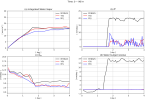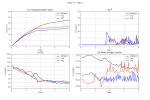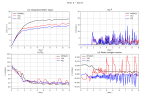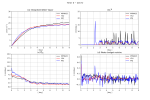Hi,
While running some idealized simulations with WRF version 4.1, I noticed severe problems in the moisture budget when using the MYNN scheme.
For a systematic test, I used the single-column model test case (em_scm_xy, no code modifications) with the attached input sounding and various PBL scheme settings (see attached namelist files).
Then I compared the accumulated moisture sources minus sinks (integral of QFX - RAINNC, only liquid precipitation occurred) to the change in total water content of the atmosphere, delta Qt:

The resulting moisture budget terms are displayed here:
View attachment waterbudget_qbud_wet_scm.pdf
For the LES (high-resolution without PBL scheme), MYJ and YSU schemes the two curves (red and violet) are reasonably close to each other, whereas for the two MYNN scheme variants they are not.
With the MYNN2 scheme, the atmosphere keeps losing more water (large negative delta Qt) than expected from the sum of the surface moisture flux and precipitation (QFX-RAINNC).
With the MYNN3 scheme instead, the atmosphere does not lose enough water given the large amount of precipitation.
Playing around with the namelist options bl_mynn_edmf, icloud_bl, scalar_pblmix, and bl_mynn_mixscalars did not change the curves significantly.
Dry air mass is conserved in all simulations, as I checked.
What is the problem here? I thought water mass should be conserved in WRF. But for the MYNN scheme, the budget is really bad!
Thanks for helping!
Matthias
While running some idealized simulations with WRF version 4.1, I noticed severe problems in the moisture budget when using the MYNN scheme.
For a systematic test, I used the single-column model test case (em_scm_xy, no code modifications) with the attached input sounding and various PBL scheme settings (see attached namelist files).
Then I compared the accumulated moisture sources minus sinks (integral of QFX - RAINNC, only liquid precipitation occurred) to the change in total water content of the atmosphere, delta Qt:

The resulting moisture budget terms are displayed here:
View attachment waterbudget_qbud_wet_scm.pdf
For the LES (high-resolution without PBL scheme), MYJ and YSU schemes the two curves (red and violet) are reasonably close to each other, whereas for the two MYNN scheme variants they are not.
With the MYNN2 scheme, the atmosphere keeps losing more water (large negative delta Qt) than expected from the sum of the surface moisture flux and precipitation (QFX-RAINNC).
With the MYNN3 scheme instead, the atmosphere does not lose enough water given the large amount of precipitation.
Playing around with the namelist options bl_mynn_edmf, icloud_bl, scalar_pblmix, and bl_mynn_mixscalars did not change the curves significantly.
Dry air mass is conserved in all simulations, as I checked.
What is the problem here? I thought water mass should be conserved in WRF. But for the MYNN scheme, the budget is really bad!
Thanks for helping!
Matthias




